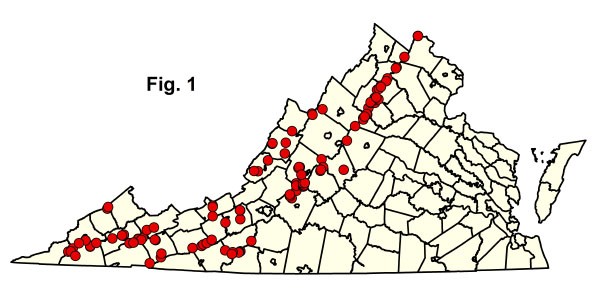
 Sở Bảo Tồn và Giải Trí
Sở Bảo Tồn và Giải Trí Bảo Tồn. Bảo Vệ. Tận Hưởng.
 Sở Bảo Tồn và Giải Trí
Sở Bảo Tồn và Giải Trí  Mục lục
Mục lụcRừng Rich Cove
The mixed hardwood forests of this group occupy fertile, mesic, mountain-slope habitats at elevations ranging from about 300 m (1,000 ft) commonly to 1,100 m (3,600 ft), and occasionally higher. Distributed locally throughout western Virginia, these forests are strongly associated with moist, sheltered, landforms (i.e., coves, ravines, and concave lower slopes). Soils may be weathered from various substrates but are generally moderately acidic to moderately alkaline, with high base saturation. In these habitats, soil fertility appears to be strongly correlated with high base cation levels (particularly calcium, magnesium, and manganese) rather than with high pH, and higher-elevation sites often have soils with surprisingly low pH. Characteristic trees include sugar maple (Acer saccharum), basswoods (Tilia americana var. americana and var. heterophylla), white ash (Fraxinus americana), tulip-tree (Liriodendron tulipifera), bitternut hickory (Carya cordiformis) and yellow buckeye (Aesculus flava); chiefly south of the James River). Herbaceous growth is lush with spring ephemerals and leafy, shade-tolerant forbs such as blue cohosh (Caulophyllum thalictroides), yellow jewelweed (Impatiens pallida), large-flowered trillium (Trillium grandiflorum), wood-nettle (Laportea canadensis), common black cohosh (Actaea racemosa), sweet cicely (Osmorhiza claytonii), Virginia waterleaf (Hydrophyllum virginianum), large-leaf waterleaf (Hydrophyllum macrophyllum), large-flowered bellwort (Uvularia grandiflora), red trillium (Trillium erectum), yellow violets (Viola pubescens and Viola eriocarpa), white baneberry (Actaea pachypoda), two-leaved miterwort (Mitella diphylla), goat's-beard (Aruncus dioicus var. dioicus,), yellow mandarin (Prosartes lanuginosa), showy skullcap (Scutellaria serrata), eastern blue-eyed-mary (Collinsia verna), Guyandotte beauty (Synandra hispidula), glade fern (Homalosorus pycnocarpos), and many others. Compositional variation related to substrate and elevation is complex but the group partitions convincingly into several major community types. The principal threats to rich cove forests are logging and invasion by shade-tolerant, non-native weeds, especially garlic-mustard (Alliaria petiolata). The frequent to common white ash component of these communities is undergoing widespread mortality from Emerald Ash Borer outbreaks.
Rừng Rich Cove và Rừng dốc được phân biệt với Rừng ẩm cơ bản tương tự ở chỗ phân bố hạn chế hơn trên núi; xuất hiện ở độ cao lớn hơn; và thành phần thực vật có một số loài chủ yếu có nguồn gốc từ Appalachian, ở độ cao lớn hơn.
Tài liệu tham khảo: Coulling và Rawinski (1999), Fleming (1999), Fleming và Coulling (2001), Fleming và Moorhead (1996), Fleming và Moorhead (2000), Johnson và Ware (1982), Olson và Hupp (1986), Rawinski và cộng sự (1994), Rawinski và cộng sự (1996), Rheinhardt và Ware (1984).
Nhấp vào đây để xem thêm ảnh về nhóm cộng đồng sinh thái này.

Phân loại nhóm này dựa trên phân tích các lô 119 được lấy mẫu ở các quận 34 của Virginia (Hình 1). Hầu hết các lô đất cũng đã được phân tích trong nhiều nỗ lực phân loại khu vực, đa tiểu bang của Cục Công viên Quốc gia (ví dụ: các dự án lập bản đồ thảm thực vật Vùng thủ đô quốc gia và Đường mòn Appalachian). Cần thu thập thêm một số dữ liệu để xác định phạm vi địa lý đầy đủ trong tiểu bang của bốn loại được phân loại. Nhấp vào bất kỳ mã CEGL nào được tô sáng bên dưới để xem mô tả USNVC toàn cầu do NatureServe Explorer cung cấp.

 Tải xuống bảng tính thống kê tóm tắt thành phần cho từng loại cộng đồng được liệt kê bên dưới.
Tải xuống bảng tính thống kê tóm tắt thành phần cho từng loại cộng đồng được liệt kê bên dưới.

